· 9 min read
The Biggest Mobile Gaming Consumers In 2018 (And Beyond) Are Women
Jacqueline Zenn
Content Crafter at GameAnalytics
Some of us may associate gaming with guys more than we do girls, and when we picture them, it’s often the stereotypically geeky or nerdy sort. It’s an image that gaming can’t often shift, and that’s despite the fact gaming of all kinds has become pretty mainstream! From eSports on ESPN to mobile games becoming some of the most popular apps in the world, gaming is hardly limited to one gender or a few niche interest groups.
In fact, in the realm of mobile gaming, women are more likely to be avid participants than men! According to a 2017 Google Play and NewZoo survey, 65% of U.S. women ages 10-65 play mobile games – and that is a huge audience. What’s more, according to the same survey, women make up nearly half – 49% – of all mobile gamers, and they tend to play more frequently than their male gamer counterparts, making them more likely to become habitual (and therefore lucrative) players.
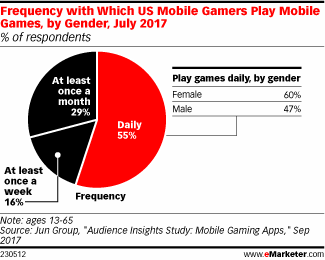
So what’s with the lack of inclusion in the gaming world? In addition to the often hostile world of desktop and console games (see the GamerGate controversy as just one example), there’s still somewhat of an industry perception that women simply don’t play video games. Yet, that’s far from true – women are actually gaming more than ever before, particularly on mobile.
[bctt tweet=”Here’s why 2018 and beyond will be all-important for diversifying your audiences.” username=”GameAnalytics”]
It’s All Thanks to Smartphones
There are many reasons why women start to play mobiles, or indeed any game at all. Maybe the narratives or action appeal, maybe they have friends or significant others who play, or maybe they just saw an ad for a given game one day and were intrigued. Perhaps one of the most important drivers for the growth in female gamers is the smartphone.
There’s something to be said for both the relative convenience of using your smartphone to play games (it is habit forming after all) and the fact that many mobile games are simple to learn and easy to play during one’s downtime. See the graphs courtesy of the aforementioned survey – clearly the increase in smartphone ownership has a connection to the proliferation of women playing mobile games:
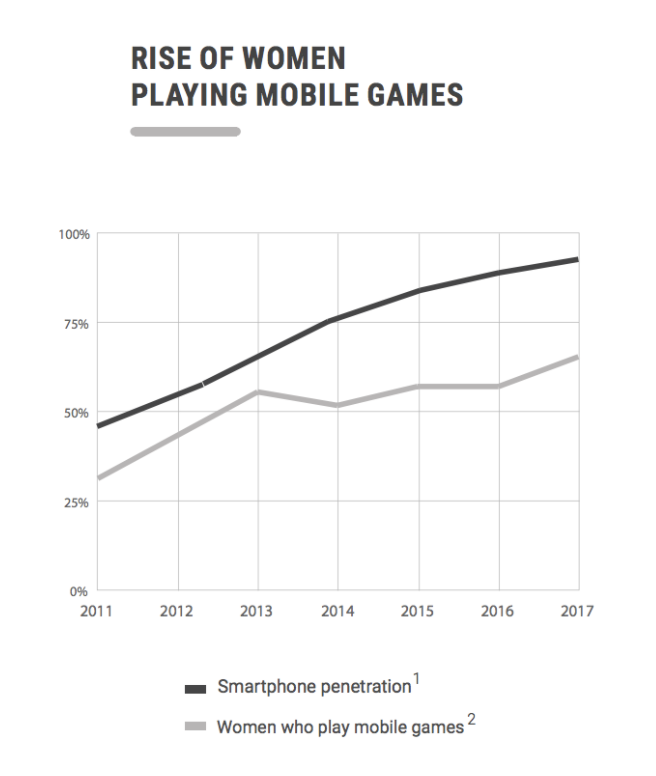
In fact, women tend to prefer playing games on their smartphones or tablets as opposed to any other platform or device.
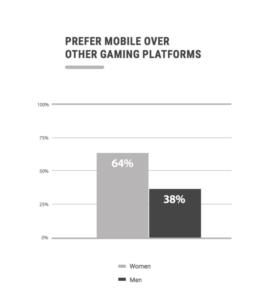
And it’s clear they play whenever and wherever they have a minute or two to take a break, since mobile games are ideal for a moment of respite wherever they might be at time, or whatever they might be doing:
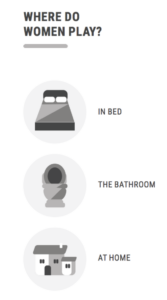
Mobile games serve as a source of quick, boredom-beating entertainment, a bit of stress relief and a distraction from real life worries, and simply as a restful moment (such as gaming in one’s downtime). Moreover, 60% of women say that gaming makes them feel good, and since mobile gaming is quick and easy – the game is always on their person – it’s easy to play while on the go. As Refinery29 says in their dive into women and mobile gaming, women haven’t been historically well-served by the sedentary nature of video games, but mobile gaming changes the story here, since they can play anywhere.
These myriad factors are definitely something for developers to keep in mind as they design and build games for the female market. It’s important to understand the why behind the rise in women playing mobile games if one is to create a game they love, after all.
What Type Of Women Play Mobile Games?

All of them! In fact, the demographic profile of the female gamer might not be what you’d expect. For instance, the average women who regularly plays games is thirty-seven years old and is financially independent – and she’s willing to spend some of her money on gaming. One third of women who regularly play mobile games are willing to spend money on games or in-game loot or gear, making the female audience an excellent and currently underserved market for game developers.
Plus, the average female gamer might not be your typical gaming geek! With the barrier to entry extremely low – many mobile game are free to play, and nearly everyone already owns a smartphone already (as opposed to a console or desktop game, which tend to require more expensive equipment to get started). On the contrary, women who play mobile games come from every walk of life and profession, from the mom who plays while her kid is napping or at sports practice, to the young professional who sneaks in sessions at her desk, to the retiree who wants to keep up with the latest technology and keep their mind sharp.
The Industry’s Current Problems (And Opportunities)
Men are still at the forefront of the gaming industry, both in terms of development and production and as the primary audience to cater to; this despite the fact that women clearly love gaming as well. The survey also points out there is still a systemic bias in the industry, with 25% of men preferring to play games with those of their own gender, a number that rises to 47% with gamers who played more than ten hours per week (women stayed consistent at around 10% regardless of time spent on games). Furthermore, women are underrepresented in the gaming industry – a fact that probably surprises no-one reading this, but a fact nonetheless. Over time, this can be a real problem, especially in regards to creating games designed to appeal to women.
It only goes to follow that gender bias and preferences have an impact on the way that women approach gaming in general. Women tend to play fewer unique games, they are less likely to purchase games or make in-game purchases, and they are less likely to invest in the game in general, whether through actual currency or just time. They are more casual than male gamers – but that’s not necessarily a bad thing for a developer! Many of the most successful games out there – Words With Friends, Candy Crush, Angry Birds, and Pokémon Go – are all pretty casual and require a low time commitment to be enjoyable.
Influence And Appearance Matter

Keep in mind that while many women gamers are simply casual players, many more are involved in the gaming world beyond simply picking up a mobile game or two. Women are interested in both games and gaming influencers, and tend to take recommendations from said influencers fairly seriously. In fact, they account for 30% of YouTube gaming video views alone, and the number is only growing. In addition, 39% of female gamers look to the advice of friends and family when considering a new game, so word-of-mouth is important as well, even if the games they are playing tend to be more of a solo endeavour.

Women tend to be more likely to play games if at least some of the characters look like them – meaning female players, villains, or other members of the game cast. Using a female character in your app store icons, screenshots, and other imagery can help immensely (if your game features “humans”); at least consider making your imagery gender-neutral if you want to attract more female players.
Moreover, you can and should test different marketing materials to see what resonates with different types of audiences, and aim for inclusiveness if you want to attract a more diverse audience, women included. And if you don’t already have female characters (again, assuming your game has gendered characters to begin with), consider testing some out! People tend to enjoy playing as a character who shares some of their own characteristics, after all.
[bctt tweet=”Making your game diverse can help you grow your audience. Find out why 2018 is the year to start.” username=”GameAnalytics”]
Consider The Full Range Of Your Audience
When you’re designing and building your game, it’s important to consider the full range of your potential audience as part of the creative development process. While the player you have in mind might be the stereotypical gamer dude (or perhaps yourself – we’re all subject to that sort of bias), keep in mind that users who don’t fit that profile might discover and even fall in love with your game. Such as women in general, an older demographic than you probably considered, or other surprises. Which is why it’s so important to consider the full range of your potential audience, and to constantly monitor and analyze your players via analytics in order to adjust and update your game accordingly.
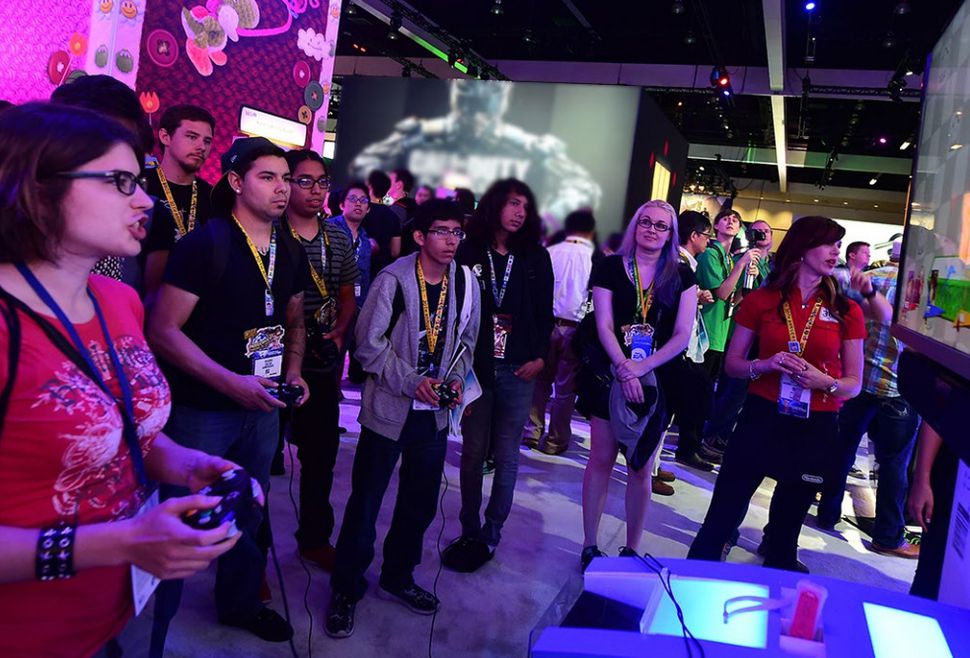
Promoting Diversity And Welcoming Female Game Developers
Diversity – of both gender and perspective – starts from within, and tapping into the rich market of women who play mobile games requires understanding their motivations and desires, and who better to do that than a fellow woman! However, only 27.8% of the gaming industry consists of women, transgender, or non-binary people according to the IGDA. While these numbers are growing, there’s always room for improvement, especially considering how popular mobile gaming (along with other forms of gaming) is with women!
Making the industry a more welcoming place for female developers is easier said than done, however, but awareness, being open to learning from female voices, and most importantly, encouraging, supporting, and listening to your female peers is essential. After all, people who don’t feel comfortable participating won’t play your game.